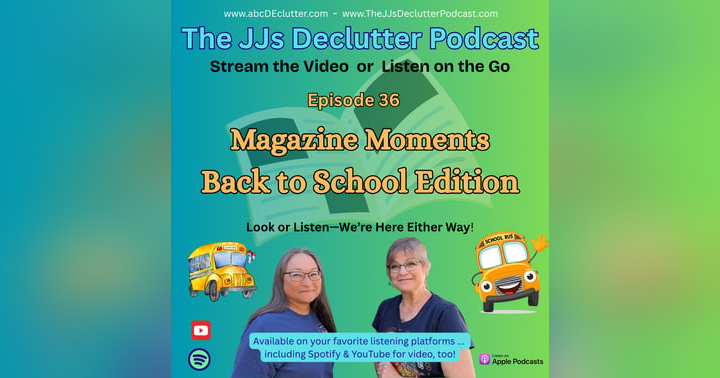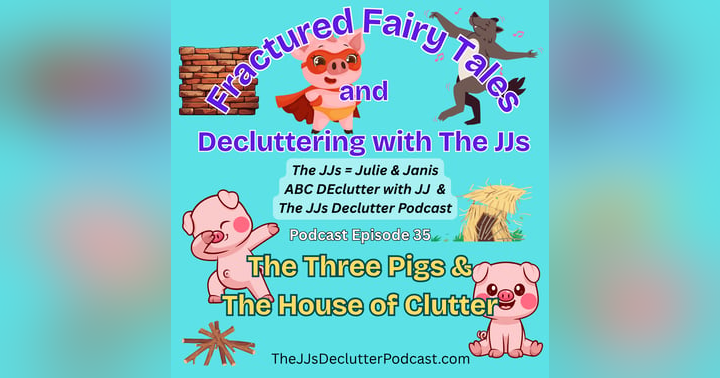Ep 28 -Garden Gnomes & Garage Goblins: Taming Outdoor Chaos (Before It Takes Over Your Life)

Originally aired on The JJ's Declutter Podcast - Episode 28
Picture this: You own ten trowels but can't find a single one when it's time to plant. Your garage has transformed from a noble shelter for vehicles into a mysterious realm where old hoses, broken bikes, and mystery buckets go to retire. If your potting bench looks like a compost pile and your garage has become a goblin's hoard, you're definitely not alone.
Welcome to the wild, overgrown world of outdoor organization—where clutter meets its match, and sometimes that match is a rusty trowel hiding under a mountain of seed packets from 2017. Or 1917, depending on how deep the archaeological dig goes.
The Great Garden Tool Roundup: A Tale of Spatial Relocation
Let's start with the classic gardener's dilemma: tool multiplication. You know you bought gardening tools. You distinctly remember purchasing them. Yet when you need to dig, plant, or prune, they've mysteriously vanished into what Julie calls "spatial relocation"—that mystical process where essential items transport themselves to impossible locations.
The "Rusted, Busted, or Crusted" Rule
Here's the JJ's golden rule for garden tool evaluation: If it's rusted, busted, or crusted—let it go, let it go. (Yes, we're channeling our inner Elsa here, and yes, it works.)
Step-by-step tool taming:
-
Layout everything and group like with like - Diggers with diggers, pruners with pruners, sprinklers with sprinklers. You'll be amazed at how many duplicates emerge from the shadows.
-
Apply the three-part test - Rusted beyond saving? Busted and unfixable? Crusted with mysterious substances? Into the discard pile it goes.
-
Clean what survives - Oil moving parts, sharpen blades, and give everything a proper cleaning.
-
Store with intention - Use labeled hooks or tool racks. Make frequently used tools visible and accessible at eye level.
The goal isn't to have the most tools—it's to know where your essential tools are when you need them.
Pot Hoarding and Seed Sprawl: The Container Conundrum
Raise your hand if you've got 47 plastic pots stacked like a leaning tower of terracotta. Janis definitely can, thanks to her husband's container gardening enthusiasm. Add in half-used seed packets from various decades, and you've got a storage situation that's part archaeology, part wishful thinking.
The Truth About Seeds (That Nobody Talks About)
Those ancient seed packets aren't necessarily worthless. While germination rates decrease over time, properly stored seeds can surprise you. Julie successfully grew plants from seeds her aunt gave her over 20 years ago. The key is realistic expectations—you might get fewer plants, but heirloom varieties often carry family garden history worth preserving.
Seed organization that actually works:
- Use a photo box or binder system - Date and label packets, discard obviously expired ones
- Try hanging shoe organizers - They don't take much space and can hold hand tools, seed packets, and gloves in one compact location
- Check for seed libraries - Many local libraries now offer seed checkout programs where you can "borrow" seeds without returning packets
Pro tip: If you're on SNAP benefits, you can purchase vegetable seeds using those benefits—they count as food because you're growing edible crops.
Container control strategy:
- Sort pots by size and nest them efficiently
- Keep a reasonable number for your actual gardening needs
- Donate or recycle excess containers to other gardeners
The Garage of DOOM: Didn't Organize, Only Moved
Ah, the garage—once a noble shelter for chariots, now the final resting place for everything that doesn't have a designated home. The acronym DOOM stands for "Didn't Organize, Only Moved," which perfectly describes how many garages evolve from functional spaces to storage graveyards.
Julie discovered three snow shovels in her Washington garage, which makes perfect sense. Janis almost mentioned finding "old hoes" before catching herself and dissolving into laughter—though let's be honest, old garden hoses are probably just as problematic in most garages.
Creating Order from Garage Chaos
Clear storage systems:
- Use transparent bins and label everything extensively
- Install ceiling racks for bulky seasonal gear (or utilize rafters for overhead storage)
- Add pegboards for vertical tool storage
- Invest in large hooks for hanging bigger items like sawhorses
Seasonal rotation strategy:
- Create designated seasonal zones
- Use color-coded bins (blue for summer, red for winter, green for garden items)
- Rotate access by quarter—store current season items at the front
- Store items where they'll be used—don't keep hose nozzles in the attic unless you're preparing for rooftop firefighting
Building Your Outdoor Command Center
The secret to outdoor organization success is shifting your mindset from "storage graveyard" to "command center." Your garage or shed should function as mission control for outdoor activities, not a place where useful items go to disappear.
Zone Creation That Makes Sense
Garden zone: Tools, seeds, pots, soil amendments, and small equipment
Sports zone: Seasonal recreation gear, bikes, balls, and outdoor games
Project zone: Home improvement supplies, paint, repair materials
Seasonal zone: Holiday decorations, pool equipment, winter gear
Mobility Solutions (That Actually Work)
Rolling carts and tool caddies work wonderfully for some people, especially seniors who appreciate not having to lift heavy items. Julie's husband prefers fixed storage locations where tools live in designated spots, eliminating extra steps in his workflow.
One ingenious solution Julie shares: using an old plastic snow sled as a garden cart. It glides over grass easily, holds substantial amounts of yard waste, and even when fully loaded, remains manageable to pull.
Composting and Garden Supply Storage
If you're into composting or making your own fertilizers, you'll need space for various stages and supplies. Janis's husband used to make homemade fertilizer using an old Vitamix in the garage—fair warning, the smell was intense enough to make them question whether the dog had digestive issues.
For simpler composting, Julie uses a basic black bin system: dump materials in, stir monthly, add shredded paper for brown material. Low maintenance, effective results.
The Weekly Maintenance Magic
Here's where the real magic happens: 12 minutes of weekly attention prevents 3+ hours of seasonal purging. That's not a typo—twelve minutes.
Weekly garage/garden check routine:
- Return tools to designated spots
- Clear surfaces of accumulated items
- Quick assessment of what's been sitting unused
- Weather protection check for sensitive items
- Mental note of anything that needs attention
This isn't about achieving perfection—it's about maintaining functionality. When you consistently spend a few minutes keeping things in their designated homes, you avoid the overwhelming multi-hour organizing marathons that make outdoor spaces feel impossible to manage.
Practical Takeaways for Real Outdoor Spaces
Start with what bothers you most. If you can never find gardening gloves, focus on creating a designated glove station. If tools constantly migrate, establish a tool return system.
Embrace the "good enough" principle. Your garage doesn't need to look like a home improvement magazine. It needs to function for your actual lifestyle and activities.
Consider your physical limitations. Store frequently used items at appropriate heights. Use wheeled solutions if lifting is problematic. Make the space work for your body, not against it.
Plan for seasonal transitions. Accept that some reorganization happens naturally with season changes. Build systems that accommodate this rhythm rather than fighting it.
Include family members in the system. If other people use the space, get their input on what works and what doesn't. The best organizational system is one everyone will actually use.
Taming the Outdoor Chaos: Your Action Plan
Whether you're dealing with a gnome invasion or goblin clutter, sustainable outdoor organization comes down to consistent, manageable maintenance rather than heroic weekend overhauls.
This week's assignment: Choose one category (tools, containers, or seasonal items) and apply the "rusted, busted, or crusted" evaluation. Spend 30 minutes maximum. See what you discover.
Remember: The goal isn't to eliminate every bit of outdoor clutter—it's to create functional systems that support your actual outdoor activities without causing stress or frustration.
Your garage and garden spaces should enhance your outdoor enjoyment, not create barriers to it. Sometimes that means accepting that you have more pots than strictly necessary, and sometimes it means finally admitting that the mystery bucket from 2019 can probably find a new home.
Keep it simple, keep it intentional, and as always—keep decluttering, even when it involves navigating around spatially relocated trowels and the occasional sawhorse hanging over doorways.
Want to hear Julie and Janis navigate the hilarious world of outdoor organization, complete with unexpected Frozen references and detailed discussions of composting smells? Listen to Episode 28 of The JJ's Declutter Podcast, where practical outdoor organization meets real-life humor.
Connect with The JJ's:
-
📺 YouTube: https://www.youtube.com/@abcdeclutterwithjj
📸 Instagram: https://www.instagram.com/abcdeclutterwithjj/
📘 Facebook: https://www.facebook.com/groups/abcdecluttercommunity
🖥️ Website: https://www.abcdeclutter.com/
🎙️ Podcast Website: https://www.thejjsdeclutterpodcast.com/
🖥️Email: hello@abcdeclutter.com
What's your biggest outdoor organization challenge? Share your garden gnome or garage goblin stories in the comments below!

